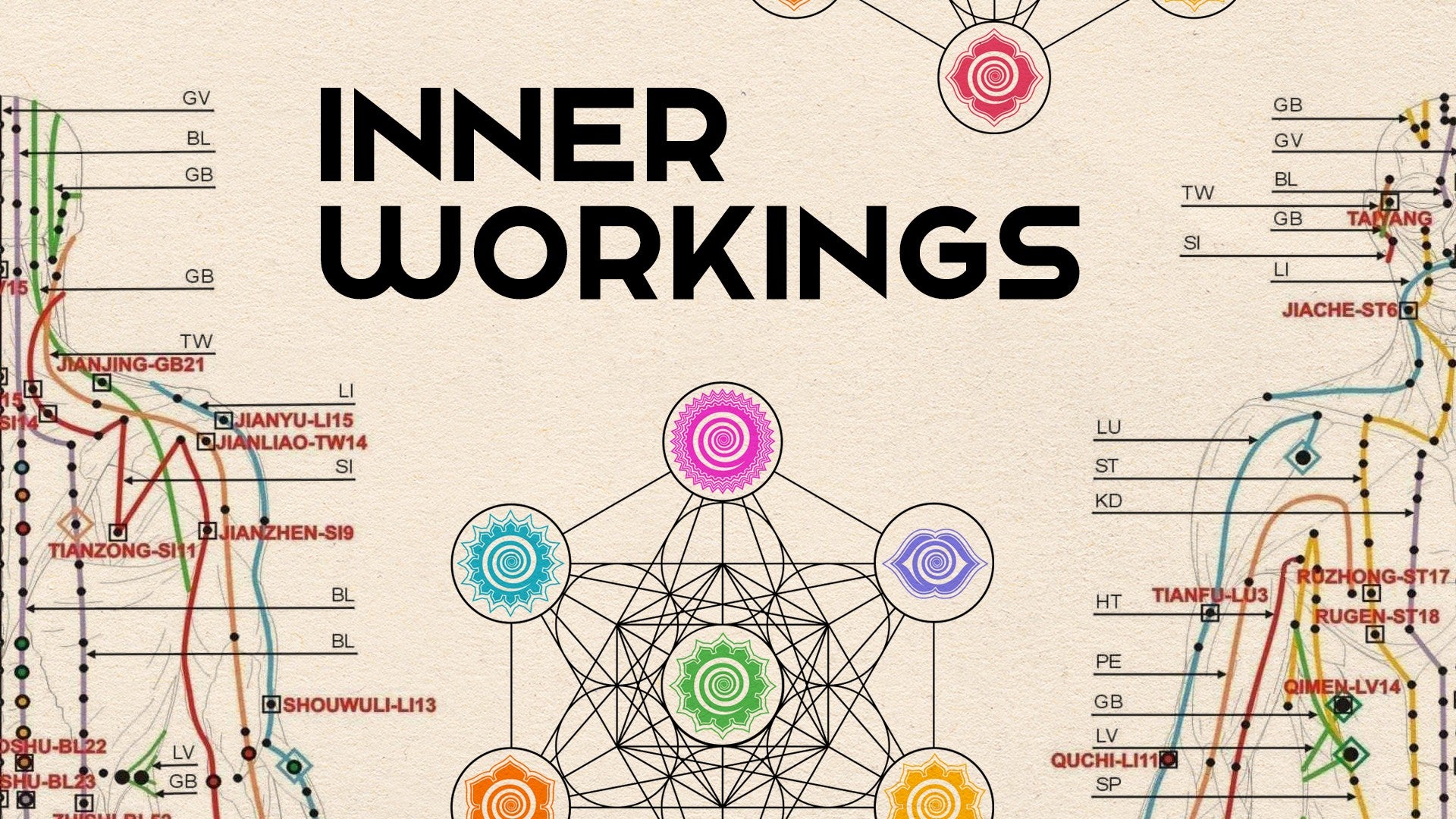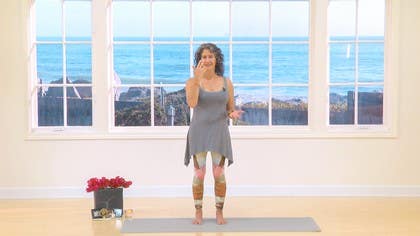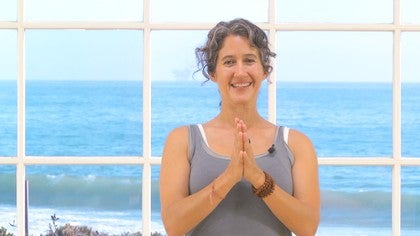Description
About This Video
Transcript
Read Full Transcript
(swooshing waves) Welcome back, and thank you, Casey, for being here. Thank you. So Casey's been practicing yoga, and I have the hiccups, so those are here too. Casey, you've been practicing yoga about 18 years? And Casey and I get to work together here at YogaAnytime.
Casey's part of the creative team in making these, there are my hiccups, in making these videos. So what she's agreed to do today is help me demonstrate how you might find this connection between the hip rotation and the feeling tone of the breath in the nostrils. Sometimes these are easier to find on our own, but really most things are easier to find in relationship. And so if you're lucky enough to have a buddy who will help you find it then you would play Casey's role and you'd have your buddy play my role. So Casey, again, thank you for being here, and if at any time while we're working together, if at any time while I'm demonstrating this, if you want it to stop, just say stop.
Okay, so I'm gonna ask Casey to lie down on the mat with her feet towards me. Now, before you go to touch anybody, absolutely key, okay, is that you find your way into yourself. So before I endeavor to be of use to Casey, I need to connect into myself. So it's a big, deliberate inhale, and it's an exhale everything and I'll just let my palms open and I'll soften my hands. And if you remember in some of our earlier sequences, right, in some of our earlier sequences, the willingness to let your hands feel more sensitive, and like really wait, really wait for this to occur.
And then when you feel ready, okay, you're gonna find yourself up in kind of a squatish position, and you're gonna find your partner's ankles and you're gonna lift his or ankles a little bit up off the Earth and then you're gonna find your arms on your thighs, and notice what my back is doing, notice how I'm lengthening my back, heart is open, I'm not rounding the back. So you wanna make sure you're comfortable, so you could also sit in a chair. And then I just check in with my friend. Casey, does that feel okay where I have my hands? Yes.
Okay, and then step one is sometimes it's hard to give your legs to another and so what I'm gonna start to do is what we call traction action. So I'm just dragging Casey towards me and then she's rebounding back. So I'm not pushing her, I'm just creating traction. You just do that for a little bit. And then you move in to what we usually call the shimmy-shake so.
And if you add a sound effect, it's more effective. And then traction action, and the purpose of this opening between the traction action and the shimmy-shake, the purpose here is just to kind of help her soften some of the tension in her legs. And most people find that they can do this. They can do the traction action and they can do the shimmy-shake. This third possible move, some people have some trouble with.
But what it is is it's almost you're creating an action like walking in her legs. So I'm holding one heel and then the other, is that okay? Okay, I'm pulling one heel and then the other, one heel then the other. So it's creating like a little disco wiggle in her hips and around her saker. It's a very similar effect if you will remember from season one how we were playing with the shimmy, it's a very similar effect.
Traction action. And then what I'm gonna ask Casey to do as I sort of separate her feet, what I'm going to ask Casey to do is Casey, will you please now bring your awareness to the breath in your nostrils. So as she brings her awareness to her breath in the nostrils then my job, okay, is to create that rotation in her hips so she can sense if there's any change of where the breath is in her nostrils and so I'll just ask her to focus on the breath in your nostrils and I'll just so gently like, just like so gently, I'll just rotate her hips to allow her toes to come towards each other and they're just going to stay there a little bit so she can become sensitive to that and then I'll just rotate her hips so that her toes turn out. So very similar to what we've been playing with. And then her job is to just become sensitive and not always like, just because I'm saying something might be available doesn't mean it is.
Rotating them out. And then because I mean, I might just ask, Casey, do you feel any shift in the breath in your nostrils when we do that? Is that available? I go to my outer nostrils when my feet turn in and my inner nostrils now as my toes are turning out and away from each other. You go more towards your inner when your toes are turned out?
Yeah? Yes. Cool and you more towards your outer when your toes are turned in? Yes. Cool.
And so you might have the same results as Casey or you might have different. The purpose is to notice what's happening. Nice. Okay and then eventually, after you've done that for a little bit then what usually feels really nice is you kind of swing your partner's legs a little side to side and then I'm going to find now, you really have to make sure you're at the right height distance with your partner. If you're working with a partner with supermodel legs and you're on the more petite side, this is hard but if you're the right height, you dig his or her feet into your guts and then you just gently lean over and as I do that, Casey is as I offer that weight, does that feel okay?
And then Casey just notices what happens in her breath. Yeah. And did you feel any change in your breath? It's lengthening. It's lengthening?
Does that feel okay? Sometimes, you can-- It feels good. Yeah, okay. You always want to check in. These, these partner exercises aren't for everybody.
So Casey's feeling a lengthening in her breath. Some people feel a deepening or widening. Okay and then when you feel like you've had enough of that, you release and you hold your partner's heels and then to come out, you do, we call this the oompa loompa. Kind of go a little side to side to side to side and then as you go to put your partner's legs back down, you just let them come about a little wider than their hips and then this last part's important. You just find their thigh and you just shaky shaky shaky, kind of avoid their knee and then shaky shaky shaky and then put their heel back down and then whoosh and then shaky shaky shaky, avoid their knee and then shaky shaky shaky and then whoosh.
Nice. And you can stay there, whoa. Sometimes, you'll notice that you've, when you've done that, their shoulders have risen up because you've lengthened their body. So a little adjustment in there can sometimes feel good. Okay.
Nice. And so the play, actually, you laying there makes me feel like Dr. Frankenstein or something but that's okay. The play here is just to allow a partner to help create the rotation in the hips to see if that allows you to feel anymore sensitivity in that. Thank you, Casey, for being here. Thank you for being here.
We'll continue the lesson plan and we'll bring these ideas towards standing.
Inner Workings: From the Visible to the Invisible
Comments

You need to be a subscriber to post a comment.
Please Log In or Create an Account to start your free trial.







